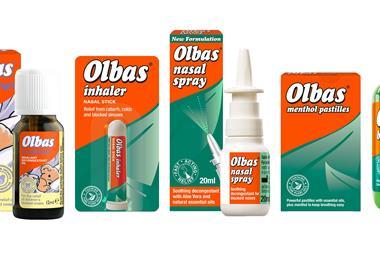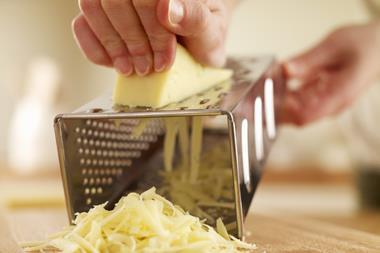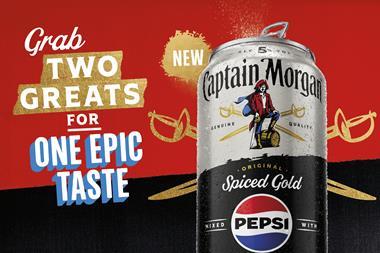Pet food buyers are valuable customers.
Tracy West finds out just why
One of the keys to being a successful convenience store retailer is understanding consumers. However, with pet food you can't be expected to get inside the minds of cats and dogs. Instead, your job is to understand their owners - your customers. And according to HIM's Convenience Tracking Programme, pet owners are very valuable customers indeed.
The average c-store shopper spends £5.46 per visit and visits 3.5 times a week, spending £993.72 a year. But the pet owner spends £11.98 per trip, visiting 4.7 times a year, which amounts to £2,927.91.
Mars UK director Trevor West explains: "Quite simply, pet owners tend to have families and bigger houses, so as well as buying pet food in c-stores, they are also buying things such as bread, biscuits and soft drinks."
It makes perfect sense, except that not all pet owners have families; some have the pets instead. West says: "There is another group of pet owners - the dinkies (dual income, no kids) who have a good income and like to treat themselves and their pets."
West says that 56% of households own a pet, which means virtually every other person entering your store is a pet owner. "And those people should be spending £12 a visit, and if they're not then you've got to consider the possibility that you're doing something wrong."
On to the pets themselves, and cat ownership is at its highest level ever - there are 11.8 million felines in the UK, with 28% of households owning one. Says West: "People are leaving it later to have kids and have pets in the interim. It's not always practical to have a dog, so they choose a cat because they're lower maintenance."
Some 25% of households have a dog and there are 8.2 million in the UK. West says the trend is towards smaller dogs because they, too, are seen as lower maintenance. "Toy dogs are increasingly popular. People might think that smaller dogs eat less, but the good news for retailers is that they are usually fussier than larger dogs and owners tend to treat them like children and so spend more on them."
David Forbes, commercial and trade marketing manager at Butchers Petcare, says cans are the most important pack format in dog food. According to IRI data, cans account for 62% of pet food sales in
c-stores. "Cans are a must-stock item for
c-stores, but it is important to get the mix of sizes, packs and brands right," explains Forbes. He says that in
c-stores, variety six-packs are taking a greater share. Sales are up almost 45% year on year and are now valued at £3.2m.
"Dog food pouches haven't yet succeeded in the convenience sector and are worth just £1.4m and are in annual decline of 6%. However alu-trays are now worth £2.1m, with the Butcher's Choice alu-tray growing by more than 62% in value in the past year." The Butcher's Choice 150g alu-tray variety pack is currently being backed by a 'five for the price of four' offer, which coincides with the launch of smaller outers - down from six to three.
He adds that complete food is important, too, as it now accounts for 20% of dog food value sales and is growing by 17.8%. "This is another must-stock for c-stores, but space is a major challenge for smaller retailers."
Forbes says that, in general, the trend towards more premium lines continues. "Shoppers are willing to spend more on their pets, but only when they believe there's a genuine reason to do so."
Butcher's hoped to give them a reason last summer when it launched Butcher's Superior, a range of super-premium dog food, containing 40% real meat. The food comprises chunks and jelly and chunks in gravy, in cans, alu-trays and pouches. Forbes is pleased with sales so far: "In the first 16 weeks from launch our sales were ahead of our rivals, no doubt due to the high quality of the Butcher's Superior products."
Mars' West says the big profit opportunity in dog food is snacks and treats. IRI data reports that the dog snacks and treats sector is experiencing the strongest growth in dog food - up 12% last year to £151m.
"Look in Asda or Tesco and you'll see the huge amount of space they give to dog snacks and treats," says West. "It's a very profitable market as the margins are high, but convenience stores haven't cottoned on to snacks yet."
Mars' research shows that although 85% of dog owners treat their pets to the top three best-selling treats lines in the UK (Pedigree Dentastix, Jumbone and Jointcare), they are stocked in only 20% of convenience stores.
"Our research also revealed that dog owners prefer to buy dog treats in their local stores, and when you think about it, you can see why. Quite often, you'll see a dog tied up outside a local shop - you won't see that at Asda or Tesco. If someone is out walking their dog and pops into a shop, they might want to buy it a treat." He reckons that just like confectionery for people, dog snacks and treats are an impulse purchase.
"In c-stores, dog snacks and treats account for 6% of pet food sales, but in multiples it's 12 and sometimes 15%. There's a real opportunity for c-stores. We offer things like clip strips to help make stocking them easier. These strips don't take up any space and come pre-merchandised with either Schmackos or Jumbone."
The big sales opportunity in cat food is still pouches, however. Pouches are a huge success story, with cat owners willing to pay for the convenience of one easy-open pouch feeding one cat. C-store retailers have been slow to catch on, though. West says the overall UK sales split for pouches versus cans of cat food is 70:30, but in multiple convenience stores it is 60:40 and in independents it's just 50:50.
"This is very frustrating as many retailers still say 'I know what sells best in my shop'. Yes, they probably do, but do they know what could sell in their shop? It's a constant battle for us to get across the message that pouches do outsell cans, and that pet owners are willing to pay for the pouches. And obviously because they sell at a higher price point, the pouches are more profitable for the retailer."
West says the 12-packs are the biggest sellers, but that most independents don't sell them. He adds: "We've introduced a £3.50 pricemarked 12-pack especially for independents, and that's going well."
Finally, the one thing to bear in mind when it comes to pet food and pet care is the importance of these animals in their owners' lives. Research says that 98% of pet owners regard their pets as one of the family and therefore treat them as such. In the UK we've not gone quite as far as the US, where you can buy 'neuticles' (prosthetic testicles for dogs that have been neutered), spa treatments and anti-depressants for your pets. However, we are more and more concerned about what we feed our animals.
In recent years Wagg has worked hard to ensure its pet food products meet consumer needs, with the launch of complete dry dog foods for specific life stages, such as a puppy food and a 'light and senior' food. Its latest line is Wagg Complete Sensitive, a wheat- and gluten-free dry dog food which is suitable for delicate digestive systems. You might think it's a step too far, but the company is reporting strong sales.
And OrganiPets, as the name suggests, is an organic pet food that's selling well. It's going so well, in fact, that the range will be expanding next month with the launch of puppy, kitten, senior
and 'lite' versions, so owners can feed their furry friends an organic meal through every one
of its life stages.
Supreme Petfoods marketing manager Alan Walmsley says lifestyle changes have led to a growth in ownership of smaller pets such as rabbits, guinea pigs, gerbils and hamsters.
"Nowadays, it's more common for pet food to be part of the weekly grocery shop, particularly for the most popular small pets. Supermarket chains have recognised this trend and are stocking
a wider range of small animal products. But, so far, the independent grocery trade has yet to follow suit," he says.
He reckons, too, that pet owners have become more sophisticated, and in particular now fully understand the importance of good nutrition for their animal's general well being.
"Their perception of what constitutes the right pet food has changed. They're now looking for a high-quality product that has been tailored by experts to meet the specific dietary needs of their particular small animal species."
Supreme's packaging has recently been redesigned to reflect this change. The new packs illustrate the ingredients used and include a window allowing the actual product to be seen. The nutritional value of the food is further demonstrated by the inclusion of a Recommended Daily Allowance (RDA) information box, just like you see on human food. Walmsley says: "Supreme is the first manufacturer to apply this concept to pet food and prove that it is delivering 100% of their small animal's daily nutritional requirements."
The packs now also feature a realistic animal image to help owners easily identify the appropriate food for their pet.
Kelly McGuire, Mace, Manchester
"We sell more cat food than dog food. Pouches are very popular, especially when they're on offer. We often have them on at 'three for 89p' and people will buy three of these instead of a can of cat food.
"We also sell quite a lot of cat litter. We carry Catsan in three sizes and I have three regular customers who come in to buy the big size of that. But we do also have a pricemarked cheaper cat litter.
"On dog food we don't sell a lot of dry; it's mostly tins of Pedigree Chum and Butchers.
"We'll always get things in for customers if they ask. For instance, we have a customer who buys a fish block on a regular basis from us - it's fish food that lasts a few days. ideal for when people go away for a weekend."
Pet food sales grew by 5% last year to reach
£1.49bn
Cat food accounts for 52% of the market. Sales
rose 4.8% last year to reach £774m
Cans account for £157m-worth of sales
Single-serve pouches are worth £405m, up 13% last year
Dry cat food sales are worth £127m
Litter sales were up 8% last year to £65m
Cat snack and treat sales were up 18% last year to £19m
Dog food represents 43% of the pet food market. Sales grew by 4.6% last year to reach £636m
Wet dog food is worth £305m
Dry dog food is worth £180m
Dog snacks and treats is experiencing strongest growth, up 12% last year to £151m
Source: IRI grocery market, MAT October 2007
Tracy West finds out just why
One of the keys to being a successful convenience store retailer is understanding consumers. However, with pet food you can't be expected to get inside the minds of cats and dogs. Instead, your job is to understand their owners - your customers. And according to HIM's Convenience Tracking Programme, pet owners are very valuable customers indeed.
The average c-store shopper spends £5.46 per visit and visits 3.5 times a week, spending £993.72 a year. But the pet owner spends £11.98 per trip, visiting 4.7 times a year, which amounts to £2,927.91.
Mars UK director Trevor West explains: "Quite simply, pet owners tend to have families and bigger houses, so as well as buying pet food in c-stores, they are also buying things such as bread, biscuits and soft drinks."
It makes perfect sense, except that not all pet owners have families; some have the pets instead. West says: "There is another group of pet owners - the dinkies (dual income, no kids) who have a good income and like to treat themselves and their pets."
West says that 56% of households own a pet, which means virtually every other person entering your store is a pet owner. "And those people should be spending £12 a visit, and if they're not then you've got to consider the possibility that you're doing something wrong."
On to the pets themselves, and cat ownership is at its highest level ever - there are 11.8 million felines in the UK, with 28% of households owning one. Says West: "People are leaving it later to have kids and have pets in the interim. It's not always practical to have a dog, so they choose a cat because they're lower maintenance."
Some 25% of households have a dog and there are 8.2 million in the UK. West says the trend is towards smaller dogs because they, too, are seen as lower maintenance. "Toy dogs are increasingly popular. People might think that smaller dogs eat less, but the good news for retailers is that they are usually fussier than larger dogs and owners tend to treat them like children and so spend more on them."
David Forbes, commercial and trade marketing manager at Butchers Petcare, says cans are the most important pack format in dog food. According to IRI data, cans account for 62% of pet food sales in
c-stores. "Cans are a must-stock item for
c-stores, but it is important to get the mix of sizes, packs and brands right," explains Forbes. He says that in
c-stores, variety six-packs are taking a greater share. Sales are up almost 45% year on year and are now valued at £3.2m.
"Dog food pouches haven't yet succeeded in the convenience sector and are worth just £1.4m and are in annual decline of 6%. However alu-trays are now worth £2.1m, with the Butcher's Choice alu-tray growing by more than 62% in value in the past year." The Butcher's Choice 150g alu-tray variety pack is currently being backed by a 'five for the price of four' offer, which coincides with the launch of smaller outers - down from six to three.
He adds that complete food is important, too, as it now accounts for 20% of dog food value sales and is growing by 17.8%. "This is another must-stock for c-stores, but space is a major challenge for smaller retailers."
Forbes says that, in general, the trend towards more premium lines continues. "Shoppers are willing to spend more on their pets, but only when they believe there's a genuine reason to do so."
Butcher's hoped to give them a reason last summer when it launched Butcher's Superior, a range of super-premium dog food, containing 40% real meat. The food comprises chunks and jelly and chunks in gravy, in cans, alu-trays and pouches. Forbes is pleased with sales so far: "In the first 16 weeks from launch our sales were ahead of our rivals, no doubt due to the high quality of the Butcher's Superior products."
Mars' West says the big profit opportunity in dog food is snacks and treats. IRI data reports that the dog snacks and treats sector is experiencing the strongest growth in dog food - up 12% last year to £151m.
"Look in Asda or Tesco and you'll see the huge amount of space they give to dog snacks and treats," says West. "It's a very profitable market as the margins are high, but convenience stores haven't cottoned on to snacks yet."
Mars' research shows that although 85% of dog owners treat their pets to the top three best-selling treats lines in the UK (Pedigree Dentastix, Jumbone and Jointcare), they are stocked in only 20% of convenience stores.
"Our research also revealed that dog owners prefer to buy dog treats in their local stores, and when you think about it, you can see why. Quite often, you'll see a dog tied up outside a local shop - you won't see that at Asda or Tesco. If someone is out walking their dog and pops into a shop, they might want to buy it a treat." He reckons that just like confectionery for people, dog snacks and treats are an impulse purchase.
"In c-stores, dog snacks and treats account for 6% of pet food sales, but in multiples it's 12 and sometimes 15%. There's a real opportunity for c-stores. We offer things like clip strips to help make stocking them easier. These strips don't take up any space and come pre-merchandised with either Schmackos or Jumbone."
The big sales opportunity in cat food is still pouches, however. Pouches are a huge success story, with cat owners willing to pay for the convenience of one easy-open pouch feeding one cat. C-store retailers have been slow to catch on, though. West says the overall UK sales split for pouches versus cans of cat food is 70:30, but in multiple convenience stores it is 60:40 and in independents it's just 50:50.
"This is very frustrating as many retailers still say 'I know what sells best in my shop'. Yes, they probably do, but do they know what could sell in their shop? It's a constant battle for us to get across the message that pouches do outsell cans, and that pet owners are willing to pay for the pouches. And obviously because they sell at a higher price point, the pouches are more profitable for the retailer."
West says the 12-packs are the biggest sellers, but that most independents don't sell them. He adds: "We've introduced a £3.50 pricemarked 12-pack especially for independents, and that's going well."
Pampered pets
Finally, the one thing to bear in mind when it comes to pet food and pet care is the importance of these animals in their owners' lives. Research says that 98% of pet owners regard their pets as one of the family and therefore treat them as such. In the UK we've not gone quite as far as the US, where you can buy 'neuticles' (prosthetic testicles for dogs that have been neutered), spa treatments and anti-depressants for your pets. However, we are more and more concerned about what we feed our animals.
In recent years Wagg has worked hard to ensure its pet food products meet consumer needs, with the launch of complete dry dog foods for specific life stages, such as a puppy food and a 'light and senior' food. Its latest line is Wagg Complete Sensitive, a wheat- and gluten-free dry dog food which is suitable for delicate digestive systems. You might think it's a step too far, but the company is reporting strong sales.
And OrganiPets, as the name suggests, is an organic pet food that's selling well. It's going so well, in fact, that the range will be expanding next month with the launch of puppy, kitten, senior
and 'lite' versions, so owners can feed their furry friends an organic meal through every one
of its life stages.
Little ones
Supreme Petfoods marketing manager Alan Walmsley says lifestyle changes have led to a growth in ownership of smaller pets such as rabbits, guinea pigs, gerbils and hamsters.
"Nowadays, it's more common for pet food to be part of the weekly grocery shop, particularly for the most popular small pets. Supermarket chains have recognised this trend and are stocking
a wider range of small animal products. But, so far, the independent grocery trade has yet to follow suit," he says.
He reckons, too, that pet owners have become more sophisticated, and in particular now fully understand the importance of good nutrition for their animal's general well being.
"Their perception of what constitutes the right pet food has changed. They're now looking for a high-quality product that has been tailored by experts to meet the specific dietary needs of their particular small animal species."
Supreme's packaging has recently been redesigned to reflect this change. The new packs illustrate the ingredients used and include a window allowing the actual product to be seen. The nutritional value of the food is further demonstrated by the inclusion of a Recommended Daily Allowance (RDA) information box, just like you see on human food. Walmsley says: "Supreme is the first manufacturer to apply this concept to pet food and prove that it is delivering 100% of their small animal's daily nutritional requirements."
The packs now also feature a realistic animal image to help owners easily identify the appropriate food for their pet.
Retailer's view
Kelly McGuire, Mace, Manchester
"We sell more cat food than dog food. Pouches are very popular, especially when they're on offer. We often have them on at 'three for 89p' and people will buy three of these instead of a can of cat food.
"We also sell quite a lot of cat litter. We carry Catsan in three sizes and I have three regular customers who come in to buy the big size of that. But we do also have a pricemarked cheaper cat litter.
"On dog food we don't sell a lot of dry; it's mostly tins of Pedigree Chum and Butchers.
"We'll always get things in for customers if they ask. For instance, we have a customer who buys a fish block on a regular basis from us - it's fish food that lasts a few days. ideal for when people go away for a weekend."
Pet food facts
Pet food sales grew by 5% last year to reach
£1.49bn
Cat food accounts for 52% of the market. Sales
rose 4.8% last year to reach £774m
Cans account for £157m-worth of sales
Single-serve pouches are worth £405m, up 13% last year
Dry cat food sales are worth £127m
Litter sales were up 8% last year to £65m
Cat snack and treat sales were up 18% last year to £19m
Dog food represents 43% of the pet food market. Sales grew by 4.6% last year to reach £636m
Wet dog food is worth £305m
Dry dog food is worth £180m
Dog snacks and treats is experiencing strongest growth, up 12% last year to £151m
Source: IRI grocery market, MAT October 2007




























No comments yet